The MSR Asia Science Forum provides a series of seminar talks on natural sciences by invited scientists. It is a platform for scientists from diversified areas (e.g., Physics, Chemistry, Material, Biology and Environment etc.) to communicate and exchange ideas with MSR researchers and engineers.
The Science Forum plays a crucial role in bridging computer scientists and natural scientists. It helps computer scientists to understand the pressing challenges in natural sciences and help scientists in natural science to see how AI can be an integral part of their exploration.
The Science Forum is organized on a bi-weekly basis, with a lecture from a different discipline followed by a group discussion. We hope it brings an exciting time for researchers to work at the intersection of machine learning and the natural sciences!
微软亚洲科学论坛是由微软研究院举办的自然科学讲座系列,主要目的是为来自不同领域(如物理、化学、材料、生物、环境等) 的科学家、微软研究员以及工程师提供一个思想碰撞的平台。
科学论坛是连接计算机科学家和自然科学家的重要桥梁。科学论坛将每两周举办一次,邀请自然科学领域的科学家演讲并开展小组讨论。通过演讲和探讨,我们希望该论坛能够扩大微软研究院在科学研究领域的影响,促进更广泛的合作,更好地发挥微软研究院的计算科学和人工智能技术优势,推进科学发展。
关于AI4Science:
科学智能中心(AI4Science)是微软研究院(Microsoft Research)于2022年7月成立的研究团队,致力于机器学习和自然科学交叉领域的基础性研究,通过技术创新改变人类理解自然世界以及与自然世界互动的方式,展现机器学习与自然科学交叉融合的新能力。科学智能中心是一个全球性的团队,研究小组分布在自英国、中国和荷兰等多个国家。科学智能中心的研究团队由机器学习、计算物理、计算化学、分子生物学、软件开发等领域的世界级专家组成,同心协力解决该领域中一些最紧迫的挑战。
Talks
08/02/2023: Exact Density Functional Theory of Excited States, Prof. Jiali Gao
-
Abstract: In this talk, I will introduce an exact density functional theory of excited states, extending the Hohenberg-Kohn theorems for the ground state to any number of N-lowest eigenstates. It was proved that the Hamiltonian is a matrix functional of the multistate density D(r), consisting of state densities and transition densities. Then, we construct a multistate interacting system to optimize the multistate density by minimizing the subspace energy to yield the energies and densities of the N eigenstates. Importantly, a finite number of determinants, i.e., a minimal active space (MAS), is sufficient to exactly represent D(r) for the N-dimensional subspace. I will present the method of multistate density functional theory (MSDFT) and its applications to excited-state processes in photosynthesis and in photoreceptor proteins, along with examples of local valence and charge transfer excitation and core-level excitation of open-shell and closed-shell molecules. The method has been implemented in the Qbics software (http://qbics.info) at Shenzhen Bay Laboratory.
Bio: 高加力教授,计算化学和计算生物学家,国际量子分子科学研究院院士,研究领域涵盖酶催化反应动力学机制的精确量子力学研究、蛋白质-膜相互作用、生物大分子相互作用和动力学建模,并致力于发展适用于材料、溶液及生物大分子模拟的全量子力场,在多个领域做出了许多开拓性的成就,特别是他参与发展的量子力学和分子力学组合方法,为 2013 年诺贝尔化学奖做出了重要贡献。高加力教授曾获得阿尔伯特霍夫曼百年奖、世界理论化学家协会狄拉克奖章、美国化学会奖等多个重要奖项。高加力教授已在 Science、Chem. Rev.、Acc. Chem. Res.等国际著名刊物上发表文章近300+篇。引用次数累计47151,h-index 为90+。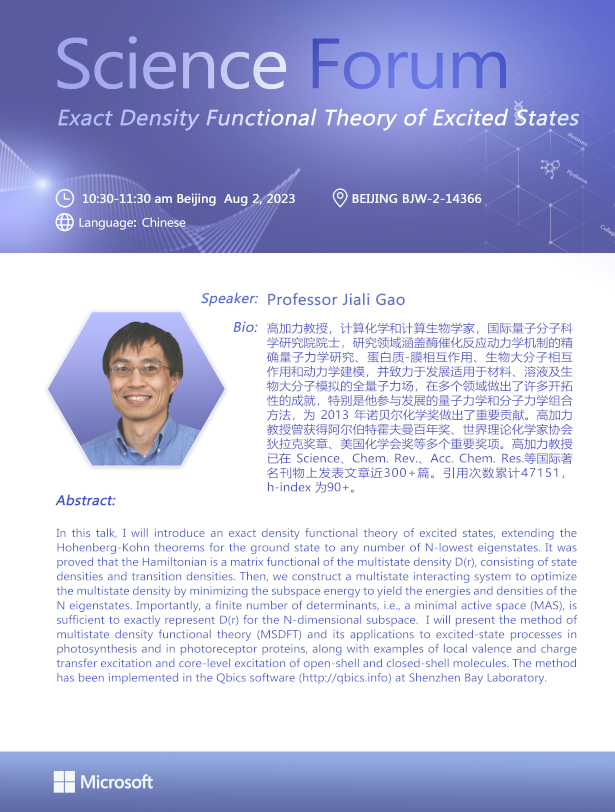
07/04/2023: Structural Approaches to Deciphering the Nature of Class B Receptor Biology and implication in drug discovery, Prof. Peishen (Elva) Zhao
-
Abstract: Metabolic disorders, such as obesity and type 2 diabetes (and co-morbidities), are major global health burdens. Current treatments are suboptimal and many are associated with side effects that limit use. My research focuses on understand the structural and mechanistic basis underlying peptide G protein coupled receptors (GPCRs) that are involved metabolic processes. My goal is to develop new chemical entities and strategies for the design of better medicines for the treatment of metabolic disorders. GPCRs are the largest family of membrane proteins, serve as the target for over 30% of the current therapeutics on the market. My talk will be focusing on the recent progresses in understanding molecular and structural basis of GPCR activation, including drug/receptor engagement, receptor/intracellular transducer conformational change, and finally integrated cellular response. I will try to provide our recent data on correlation between different pharmacological and kinetic parameters and downstream pathway activation efficacy. In the second half of the talk, I will focus on the effort from our group on solving high resolution cryo-EM structure of GPCRs in complex with different ligands and transducers. Our data revealed critical information regarding structure features of the ligands, and receptor that produce specific signalling profile. The research from our group focuses on class B1 GPCRs, and my talk will use GLP-1R as a prototype receptor to demonstrate our current drug development strategy which combine pharmacology, biochemistry and structure biology to design pathway selective compounds that provide improved clinical efficacy and reduced unwanted side effects. Finally, I will touch base on the opportunities and challenges on using our data to develop novel mathematical and computational models to facilitate future drug development efficiency.
Bio: Dr. Peishen (Elva) Zhao completed her PhD (awarded Oct 2011) at the University of Western Ontario (UWO), department of Physiology and Pharmacology. During her PhD, she received The Margaret P. Moffat Award of Excellence in Research and Academic Performance (UWO, 2011) and the Chinese Government award for outstanding post-graduate achievements abroad (2012). Dr. Zhao joined Monash University in 2012 and established independent research program focused on regulation of class B1 GPCRs by intracellular regulatory proteins in 2020. She contributed to a number of significant studies including (i) a mechanistic and structural understanding of how class B1 GPCR can pleiotropically couple to multiple G protein subtypes, (ii) identification of a novel non-peptide agonist binding sites in the GLP-1R, (iii) a mechanistic and structural understanding of GLP-1R signalling bias. She has a career total of 38 peer-reviewed publications, including lead author papers in Science and Natures. Her expertise in GPCR pharmacology, and scientific achievement by a highly competitive and prestigious ARC Future Fellowship (2020).
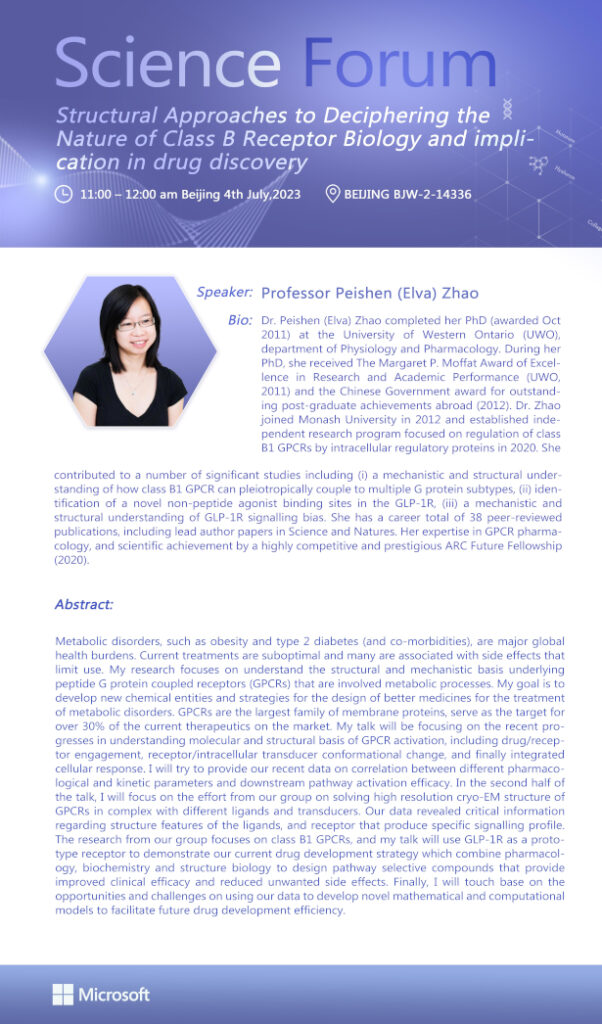
06/06/2023: Beyond The Thole Models (Polarizable Gaussian Multiple Model: recent advances in the development of Gaussian density based polarizable molecular mechanics force fields), Prof. Yong Duan
-
Abstract: Molecular mechanical force fields have been playing important roles in the studies of biomolecular structure and dynamics. With the growing interests to model biomolecules in diverse environments, polarizable force fields have been developed to accommodate the changes to account accurately the large-scale dynamics of proteins and nucleic acids. The traditional Thole models are based on the assumptions that the non-linear induction energy can be adequately modeled by smearing one of the two interacting charge centers and leaving the other as a point. We recently proposed the polarizable Gaussian Multipole model in which the multipoles of each atom are modeled as Gaussian densities. Our tests on Glycine oligomers indicate that the pGM is a robust framework that can accurately account for the many-body interaction energies. We further studied its transferability by comparing the electrostatic potentials of prototypical systems including water clusters, alanine peptides, homo-polypeptides, and nucleic acid bases. In all these systems, significant improvements in the transferability have been observed compared to fixed-charge models. We attributed these observations to the unique feature of pGM that its monopoles and multipoles are Gaussian densities making it possible to treat the intra- and inter-molecular interactions consistently.
Bio: Dr. Yong Duan is a professor at Genome Center, University of California, Davis. He received Ph.D in physics from University of Pittsburgh. He is one of the early developers of the widely used biomolecule simulation software package, Amber and the molecular force fields. His representative work includes protein folding simulations and the amber force field FF03. Prof. Duan’s main research interests are development and application of computational methods to study the structure and dynamics of bio-molecular systems, focusing on protein folding and aggregation and protein structure prediction, simulation method development, structure and dynamics of G-protein coupled receptors, DNA-protein interactions, and computer aided drug design. Recently, he focuses on polarizable force field development to improve the model accuracy in molecular dynamics simulations.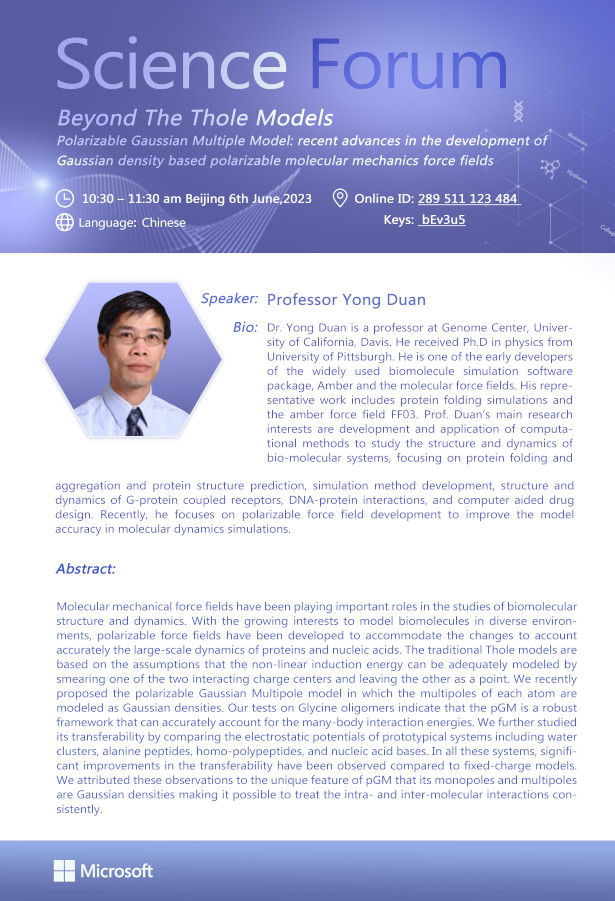
05/12/2023: Full-chain AI-powered New Drug Innovation, Prof. Jianpeng Ma
-
Abstract: In recent years, with the rapid development of AI technology, computational biology has leaped from a niche field to a leading discipline in molecular biology research. The widespread use of theoretical and quantitative analysis methods is often a sign of a discipline’s maturity. In today’s world, for any major country, computational biology is one of the key areas to occupy in order to promote innovation and development in the pharmaceutical industry. The outbreak of the COVID-19 pandemic has highlighted the importance of the biopharmaceutical industry in national economy and people’s livelihood. Computing power is The Power!
The design of new drugs is first and foremost a computational biology problem, and history has bestowed great opportunities on the field of computational biology. Our goal is to develop computational algorithms and to design novel non-natural proteins and develop new functions, new drugs, and new materials. New drug research and development is a system engineering process. For the same goal, professionals from different directions need to keep pace and work together under unified command in a “large-scale joint operation.” We have the advantage of integrated research and development from the discovery of entirely new target proteins, computational structure prediction, experimental structure determination, and the development of dedicated simulation algorithms to drug design. This report will elaborate on the progress of the Jianpeng Ma-Michael Levitt team in AI-powered new drug innovation.Bio: Professor Jianpeng Ma graduated with a Bachelor’s degree in Chemistry from Fudan University in 1985 and earned his Ph.D. from Boston University in 1995. He then conducted postdoctoral research in Harvard University, with Professors Martin Karplus and Professor William Lipscomb, both are Nobel Prize winners in Chemistry. Since 2000, he had been a professor at the world-renowned Baylor College of Medicine and Rice University, serving as an Endowed Chair Professor at Baylor College of Medicine.
In August 2018, Professor Ma joined Fudan University as a core member of the Shanghai High-Peak Talent Team. Together with Nobel Prize winner, Professor Michael Levitt, he founded the Institute of Multiscale Research on Complex Systems at Fudan University and served as its first dean. Professor Ma is engaged in life science research and teaching, making numerous innovative breakthroughs in scientific research and winning many international academic awards. He is a fellow of the American Institute for Medical and Biological Engineering, the American Association for the Advancement of Science, and the American Physical Society. He also won the 2004 Norman Hackermann Award in Chemical Research.
His research focuses on biophysics, computational biology, and structural biology. He is mainly dedicated to developing new computational methods for studying biological systems, overcoming difficulties in experimental research, and solving important problems in complex biological systems by combining experimental approaches.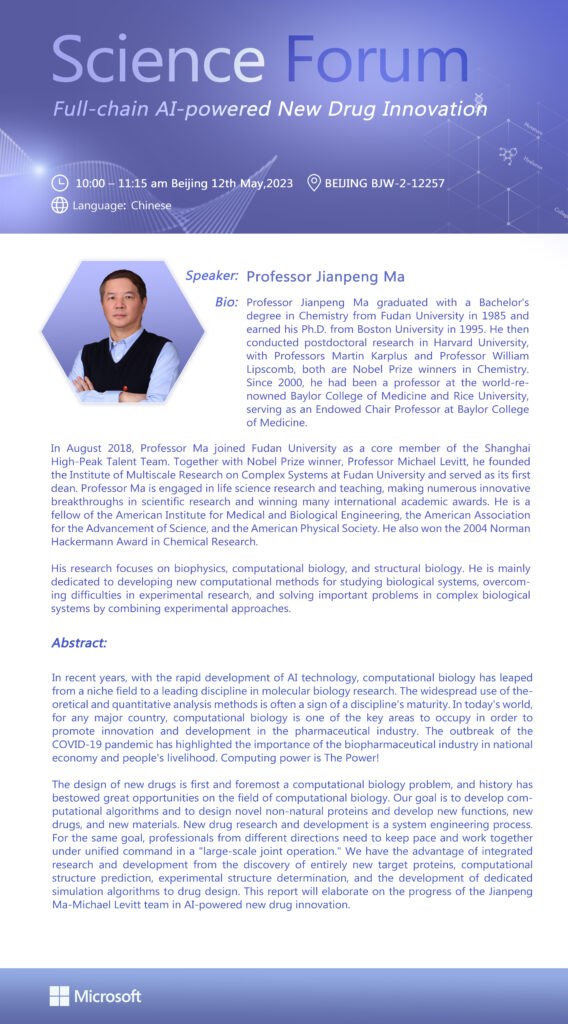
04/25/2023: Human Genomics and Metagenomics for Creating Future Medicine, Prof. Seiya Imoto
-
Abstract: We “humans” are composed of approximately 40 trillion cells, each of which contains 3 billion base pairs, the blueprint of our life, and about 21,000 genes are encoded. From these genes, various proteins and enzymes are produced to make up our bodies, and life is maintained by promoting reactions essential for vital activities such as metabolism. DNA or genomic abnormalities can cause disease. A vast number of studies have been conducted to clarify the relationship between the human genome and diseases, including hereditary diseases caused by congenital genetic abnormalities and the accumulation of acquired mutations in the genome that cause “cancer”.
In the first half of the presentation, we will introduce our efforts in the Cancer Whole Genome Project, a national project in Japan. We have decoded cancer genomes and genomes derived from normal cells in approximately 12,000 cancer patients over the two-year period of 2021 and 2022 to comprehensively identify somatic and germline mutations. In the future, the use of AI will be essential to link whole genome information to patient return and dramatically improve the accuracy of genomic medicine.
In the second half of the presentation, we will present genomic studies of microorganisms that live in symbiosis with us. It has become clear that our health and disease cannot be understood simply by examining our human genome, and the gut microbiota has become known as our “alter ego”. We will present the analysis of the mechanisms by which gut microbiota transplants restore the gut environment, and the development of methods to target specific pathobionts and control them with gut viruses.
Bio: Seiya Imoto received the BS, MS, and PhD degrees in mathematics from Kyushu University, Japan, in 1996, 1998, and 2001, respectively. He joined the Human Genome Center, the Institute of Medical Science, the University of Tokyo in 2001. He is currently director and professor of Human Genome Center. He is also served as an advisor (medical statistics) of Ministry of Health Labor and Welfare from 2016 and was an advisor of the President of the University of Tokyo in 2019-2020. His current research interests cover statistical analysis of high-dimensional data by Bayesian approach, biomedical information analysis, next generation sequence data analysis, immuno-genomics, artificial intelligence and meta-genome data analysis.
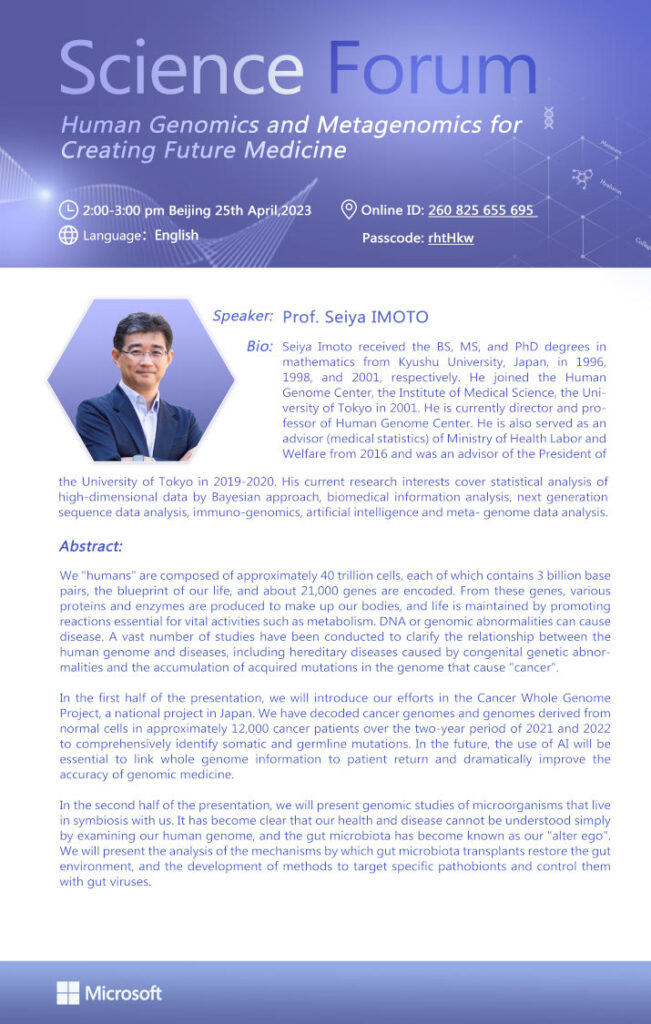
03/23/2023: Virus discovery and characterization in the genomics era, Prof. Mang Shi
-
Abstract: metagenomics is an increasingly popular tool for discovery and characterization of viruses, which have redefined the diversity of entire virosphere and completely altered our view on virus ecology and evolution. In addition to its contribution to viral genomic diversity, metagenomics contains important information which can be used to further characterize the viral pathogenicity, ecological dynamics and interactions with host and other microbes. And this forms the basis of information-driven next generation approach to study viruses that is distinguished from culture-based methodology. Here I will introduce how we can apply metagenomics on a variety of topics that include discovery, disease relevance, genomic evolution, interaction with microbes, as well as ecological dynamics.
Bio: Mang is a professor at Sun Yat-sen University. Prior to joining Sun Yat-sen University, he is a senior research associate at the University of Sydney. He is also an adjunct faculty at Shanghai Public Health Clinical Centre and before that he is an ORISE fellow and Guest researcher at the US CDC. Mang received his undergraduate and Mphil degree from the University of Hong Kong and his Ph.D. from the University of Sydney. Mang’s research is mainly focused on viruses. His work uses genomics, metagenomics, and meta-transcriptomics tools for virus discovery and characterization, based on which he has re-defined the RNA virosphere. Currently he is interested in using the same approaches to reveal the much broader topics include disease emergence, virome ecological dynamics, and the interaction between virome and microbiome.
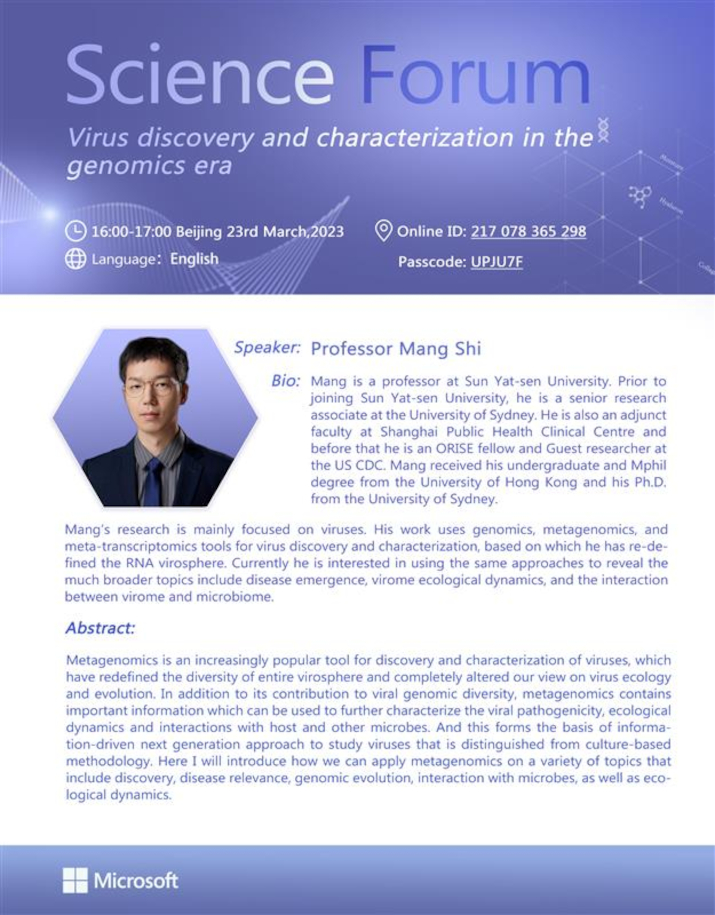
02/21/2023: An introduction to data assimilation in numerical weather prediction, Jianing Feng
-
Abstract: Introduce the basic theoretical methods of data assimilation in the field of numerical weather prediction, including Three-dimensional variation(3DVAR), Four-dimensional variation (4DVAR) and ensemble Kalman filter; 2. introduce the current open source tools for data assimilation; 3. present a real assimilation case study.
Bio: Jianing Feng is a research associate at the State Key Laboratory of Severe Weather, Chinese Academy of Meteorological Sciences. He is mainly engaged in research on typhoons, data assimilation and target observation. He has been awarded as an advanced individual in major meteorological services by China Meteorological Administration and “Outstanding” achievements in meteorological science and technology in the 13th Five-Year Plan of China. As the core developer, he developed the “Typhoon Rapid Refresh and Nowcasting System”, which was approved by the China Meteorological Administration for operational use. He has published 10 papers in Journal of Geophysical Research: Atmosphere, Weather and Forecasting, and is a reviewer for Monthly Weather Review and Geophysical Research: Atmosphere. Reviewer.
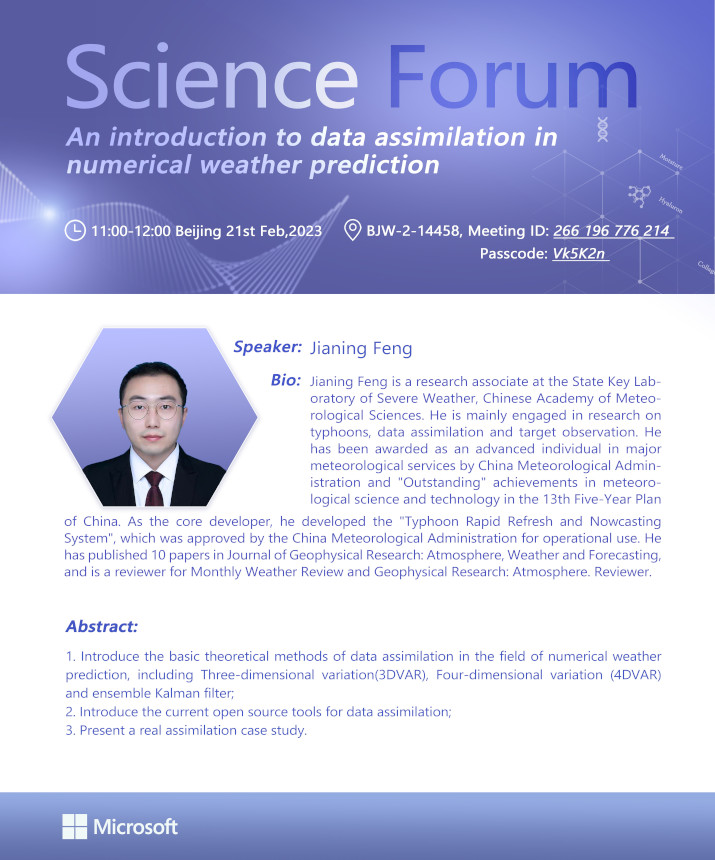
02/15/2023: Atomistic modeling of materials and chemical processes boosted by AI, Dr. Davide Donadio
-
Abstract: Atomistic modeling based on density functional theory, often combined with molecular dynamics, has been successfully employed in physics, chemistry, and materials science for about half a century. It provides a microscopic insight to interpret experimental measurements, it can unravel structure-function relations, and it enables the access to extreme conditions.
However, atomistic modeling is hampered by large computational costs, which limit the complexity and the size – in the order of few hundred atoms – accessible to accurate and predictive electronic structure methods. Conversely, the use of empirical effective potentials gives access to million atoms models but with limited accuracy and transferability.
In this talk, I will illustrate how the introduction of AI has revolutionized this paradigm by bringing together accuracy, complexity, and computational efficiency. A first set of examples will encompass the development and use of machine learning potentials to study phase transitions, to compute nonequilibrium energy transfer in liquids, and to predict the thermal conductivity of crystalline and glassy materials. Finally, the application of AI to the discovery of new inorganic energy materials will be briefly discussed.
Bio: Davide Donadio is a theoretical materials scientist and professor of chemistry at UC Davis. He earned his Ph.D. in 2003 at the University of Milan with a thesis on the photosensitivity and photoelasticity of silicate glasses by electronic structure calculations and molecular dynamics simulations. As a postdoctoral researcher at ETH Zurich (Parrinello group) and UC Davis (Galli group), he studied materials at extreme conditions, crystal nucleation, nanoscale heat transport, and thermoelectric materials. From 2010 to 2015 Dr. Donadio led the Max Planck Research Group for “Theory of nanostructures” at MPIP Mainz, investigating non-equilibrium processes at the nanoscale by molecular simulations. In 2014 he was appointed Ikerbasque professor at DIPC (Donostia, Spain), and in 2015 moved to UC Davis, where he continues his research activity on crystallization, surface chemistry, and nanophononics. He is currently an associate editor of Nanoscale and Microscale Thermophysical Engineering, and he has authored 142 peer-reviewed articles, two US patents, and three book chapters.
Dr. Donadio is a University of California Hellman fellow, UC Davis Chancellor’s fellow, Res. Corp Scialog fellow, and he was elected AAAS Fellow “For distinguished contributions to the field of computational and theoretical chemistry, particularly for theoretical modeling of materials.”
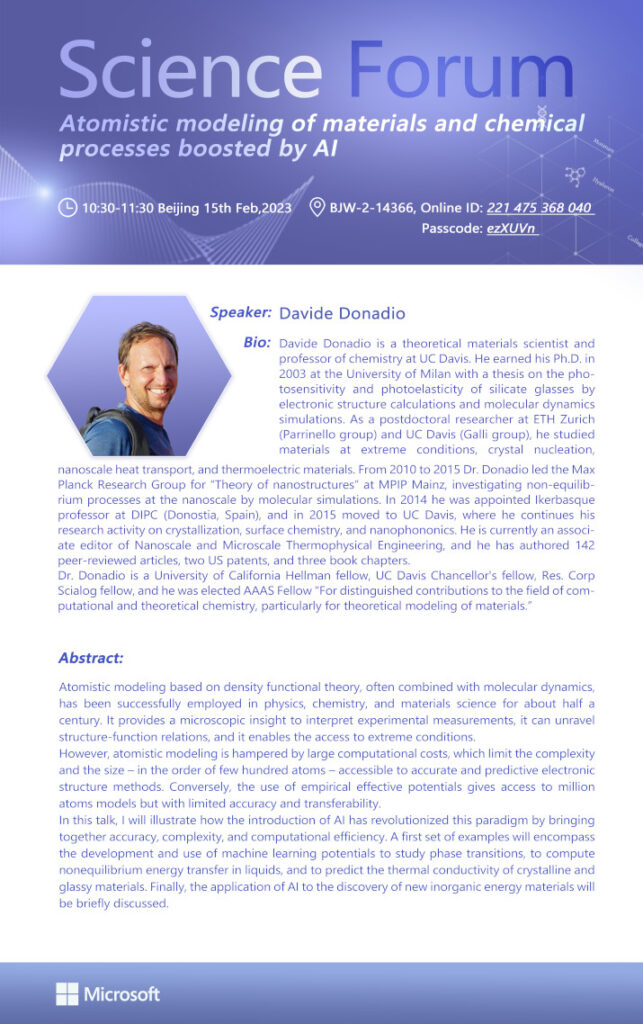
02/14/2023: Which Graph Neural Network can Provably Solve Practical Problems, Dr. Di He
-
Abstract: Designing expressive Graph Neural Networks (GNNs) is a central topic in learning graph-structured data. While numerous approaches have been proposed to improve GNNs with respect to the Weisfeiler-Lehman (WL) test, for most of them, there is still a lack of deep understanding of what additional power they can systematically and provably gain. In this work, we take a fundamentally different perspective to study the expressive power of GNNs beyond the WL test. Specifically, we introduce a novel class of expressivity metrics via graph biconnectivity and highlight their importance in both theory and practice. As biconnectivity can be easily calculated using simple algorithms that have linear computational costs, it is natural to expect that popular GNNs can learn it easily as well. However, after a thorough review of prior GNN architectures, we surprisingly find that most of them are not expressive for any of these metrics. We introduce a principled and efficient approach, called the Generalized Distance Weisfeiler-Lehman (GD-WL), which is provably expressive for all biconnectivity metrics. Practically, we show GD-WL can be implemented by a Transformer-like architecture that preserves expressiveness and enjoys full parallelizability. A set of experiments on both synthetic and real datasets demonstrates that our approach can consistently outperform prior GNN architectures.
Bio: Di He is an Assistant Professor at Peking University. He was previsouly a Senior Researcher in Machine Learning Group (now AI4Science) at Microsoft Research Asia. Di’s main research interests include representation learning (mainly focusing on learning the representation of languages and graphs), trust-worthy machine learning, and learning methods for scientific problems. The primary goal of his work is to develop efficient algorithms that can capture accurate and robust features from data through deep neural networks. Di has been serving as the Area Chair of the top machine learning and artificial intelligence conferences, including ICML, NIPS, ICLR and CVPR.
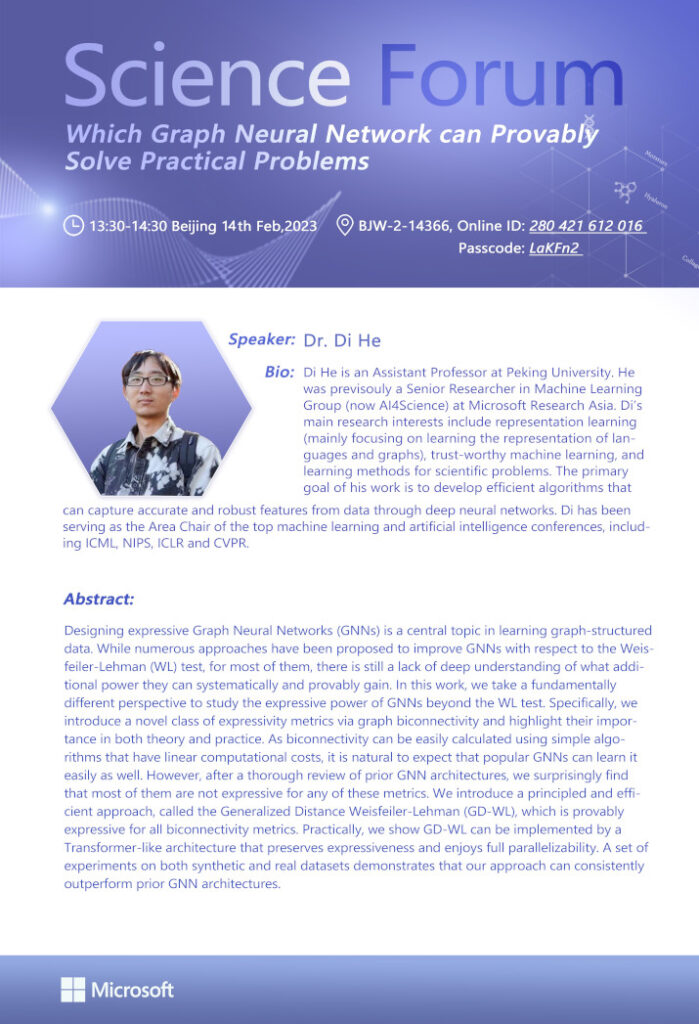
01/30/2023: Identifying drug target genes with genomics and data science, Dr. Boxiang Liu
-
Abstract: High-throughput genotyping and sequencing have led to the discovery of thousands of disease-associated variants. Because most of these variants lie in non-coding regions, their functional mechanisms remain unclear. To uncover target genes and pathways regulated by disease-associated variants, it is critical to perform functional genomic assays and develop novel computational approaches to analyze assayed information. We demonstrate the power of functional genomic assays with two diseases. Coronary artery disease (CAD) is the leading cause of death globally. It is estimated that 40 – 60% of CAD severity can be attributed to genetic factors. GWAS meta-analyses have uncovered more than 100 significant loci, but most are difficult to interpret because they reside in non-coding regions. We generated transcriptomic and whole-genome sequencing datasets in human coronary artery smooth muscle cells (HCASMC) from 52 unrelated donors and an ATAC-seq dataset on 8 donors and found that HCASMC-specific genetic regulatory mechanisms are highly enriched in CAD GWAS signals. By jointly analyzing eQTL and GWAS datasets, we identified five risk genes. TCF21 and SMAD3 has subsequently been validated by single-cell analysis in atherosclerotic mouse models. Age-related macular degeneration is one of the leading causes of blindness in elderlies. It has been estimated that genetic factors explain 45% – 70% of variation in severity of age-related macular degeneration. Retinal pigment epithelium (RPE) serves vital roles in ocular development but is underrepresented in genetic regulation studies. We performed RNA-seq in RPE from 24 donors under two metabolic conditions and discovered hundreds of shared and condition-specific eQTLs. By jointly analyzing RPE eQTL and AMD GWAS, we identified several risk genes including RDH5. In particular, we found that the eQTL regulatory SNP also regulates splicing. Experimental validation confirms that the minor allele leads to aberrant splicing and subsequently RNA non-sense-mediated decay. This result revealed the genetic mechanism of RDH5 regulation and confirmed RDH5 as a risk gene for age-related macular degeneration, making it a potential target for drug development. To facilitate functional interpretation of GWAS, we perform colocalization analysis across hundreds of traits and make all results available at www.locuscompare.com (opens in new tab).
Bio: Boxiang Liu obtained BA degree in Biophysics from Illinois Wesleyan University, a MS degree in Statistics and a PhD degree in Bioinformatics from Stanford University. During his PhD, he was awarded a CEHG fellowship, the Charles B Carrington Memorial Award, and the Chinese Government Award for Outstanding Overseas PhD. He joined Baidu Research (USA) as a Senior Research Scientist in 2019 and was promoted to Staff Research Scientist in 2021. He joined the National University of Singapore as an Assistant Professor in 2022. His research group focuses on using computational and statistical tools to understand the genetics of complex human diseases, with the long-term goal of validating known and identifying novel drug targets.
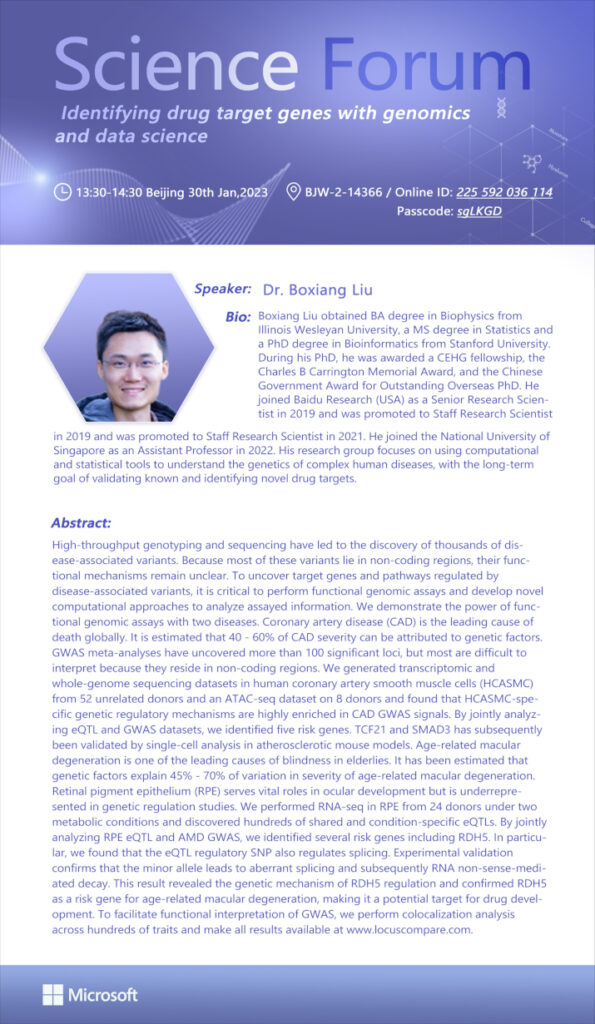
11/22/2022: 抗菌药物的发现研究, Prof. Kui Zhu
-
Abstract: 天下苦耐药久矣!细菌耐药性是21世纪全球高度关注的公共卫生领域三大威胁之一,其中动物源细菌耐药性尤其令人关注。发现原创性抗菌分子及其靶标,开展基于新靶标的分子合理设计是破解抗菌药物创制难题的必由之路。围绕耐药病原菌高效治疗的关键科学问题,我们提出广谱抗菌增效的概念,设计并合成具有提高多种抗菌药物疗效的先导化合物广谱抗菌增效剂SLAP-S25,发现并确证抗菌新靶点磷脂酰甘油及3类配体;发现并命名抗生素bacaucin(杆农素),合成系列衍生物丰富药源分子,为新型抗菌药物创制奠定分子基础;发展宿主导向的抗菌治疗策略,解析条件致病菌共感染分子机制,揭示宿主细胞介导抗菌药物耐受性的形成机制,设计靶向宿主细胞和按需给药的精准抗菌方案,揭示抗生素后病原扩散现象的新机制,为合理用药和减抗替抗提供理论依据与技术支撑。
Bio: 朱奎,中国农业大学领军教授、博士生导师,德国墨卡托学者(Mercator Fellow)、国家优秀青年科学基金获得者,美国杜克大学博士后、德国慕尼黑大学博士。围绕公共卫生领域耐药病原菌控制的核心问题开展科学研究,通过发现抗菌新靶点,研发新型抗菌药物,提高宿主导向的抗菌药物疗效,保障人和动物健康。以通讯作者含并列在Nature Microbiology、Lancet Infectious Diseases、Nature Communications等期刊以封面等形式发表论文40余篇,授权国家发明专利5项,为耐药病原菌防控和新型抗菌药物创制提供理论依据和技术支持。
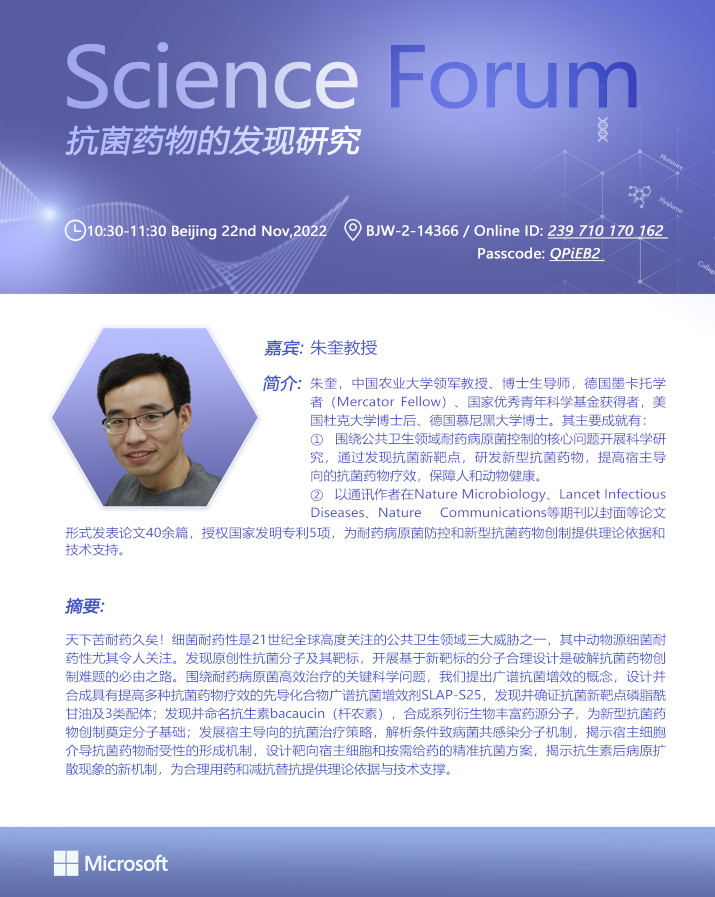
11/08/2022: Designing and Probing the Electrode/Electrolyte Interfaces for Rechargeable Batteries, Dr. Biao Zhang
-
Abstract: Electrode/electrolyte interfaces play vital roles in determining the kinetics and stability of rechargeable batteries, particularly for high-capacity alloy and metal anodes. Extensive studies have been put on the fabrication of nanostructured electrodes to alleviate the volume change during charge/discharge, dramatically improving the cyclic stability by maintaining the electrode integrity. A drawback of these nanostructured materials is their low density, leading to a low volumetric energy density for batteries. Moreover, a large irreversible capacity is observed in the 1st cycle due to the solid electrolyte interface (SEI) formation on the high surface area of nanosized materials. Instead of constructing nanostructures, we turn to engineering the electrode/electrolyte interfaces to constrain the volume expansion, which enables the stable cycling of microsized particles. An ultrathin SEI is built in the ether-based electrolytes, with amorphous particles dispersed in the polymer-like matrix. This unique nanostructure exhibits superior elasticity and renders anomalous stability against the large volume change of the anodes, as revealed by electrochemistry measurement and atomic force microscopy. We propose the maximum elastic deformation energy to predict SEI’s mechanical stability, facilitating the rational interface design.
Bio: Dr. Biao Zhang received his Ph.D. in Mechanical Engineering from the Hong Kong University of Science and Technology (HKUST) in 2013. He started post-doc research at Collège de France in 2014. Dr. Zhang joined the Department of Applied Physics at the Hong Kong Polytechnic University (HK PolyU) as an Assistant Professor in 2017. His research focuses on i) designing advanced electrode materials and ii) building robust electrode/electrolyte interfaces for rechargeable metal-ion batteries. Dr. Zhang has won several prestigious awards, including the PhD Research Excellence Award from HKUST and the Outstanding Young Researcher Award from HK PolyU.
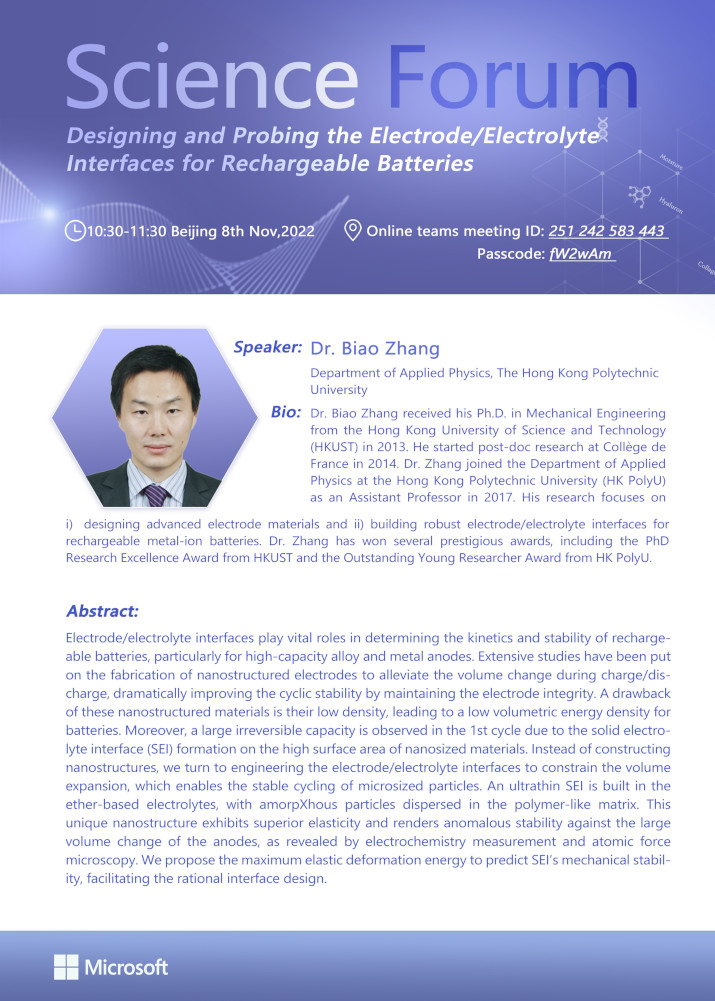
10/28/2022: HPC+AI: large scale molecular dynamics with ab initio accuracy for material science simulation (超级计算机+人工智能助力量子化学精度的大尺寸体系分子动力学模拟), Dr. Weile Jia
-
Abstract: Scientific simulation has become the third polar in the research of material sciences. Besides traditional scientific computing, the emerging AI for science is a new trend in solving high dimensional physical problems such as ab initio molecular dynamics. The system scale and mixed precision of modern supercomputers poses great challenges to the efficiency of the novel HPC+AI methods. In this presentation, I will introduce the algorithms and optimization both traditional scientific computing and HPC+AI methods on large-scale supercomputers, especially on exploiting the performance of entire supercomputer such as Summit, Fugaku and Sunway. The corresponding challenges for the computer architecture will be from the perspective of large-scale calculation of materials sciences.
Bio: Weile Jia(贾伟乐) Associate professor, Institute of Computing Technology, Chinese Academy of Sciences. My research focuses on high-performance computing, especially in efficiently carrying out density functional theory calculation with both numerical and HPC+AI methods. I am now an Associate Professor at Institute of Computing Technology, Chinese Academy of Sciences. I am very fortunate to have received the ACM Gordon Bell prize (2020). Our recent work on large-scale simulation for complex heterostructure has been selected as one of the 2022 ACM Gordon Bell Finalists.

10/25/2022: A tale of two viruses – the past and future of phantom hunting (双魔记 – 降魔之路的过去与未来), Dr. Lei Wei
-
Abstract: Where there is life, there are viruses. Numerous pathogenic viruses have caused tremendous loss to human lives throughout history and will continuing doing so for the foreseeable future. The study of virology is key to equip us with knowledge to fight against these viruses. One most recent success is the cure of hepatitis C virus infection, which is the first chronic viral infection that can be cured. Another half success is the control of hepatitis B virus infection. I will use these two human viruses as examples to describe the history and future of virology development, I will also talk about how data and computational analyses can revolutionize the virology field and our battle against viral infections.
Bio: Lei Wei is currently an assistant professor at Westlake University, Center for Infectious Diseases Research. His research interest is virus-host interactions, one of his major focuses is how to cure human hepatitis B virus infection. He received his bachelor’s and master’s degrees in Biological Sciences at Tsinghua University. He obtained his doctoral degree in molecular biology and Genetics in Dr. Xiaolan Zhao’s lab in Memorial Sloan-Kettering Cancer Center, USA. His doctoral research was focused on DNA replication and repair. He then developed an interest in the interface of DNA repair and HBV virus and joined Alexander Ploss’ lab at Princeton University as a postdoc to investigate the replication of HBV genome. He is now continuing his virology research at Westlake University.

10/12/2022: Modulating the local atomic structure of electrocatalyst materials for clean energy revolution (新一代清洁能源电催化材料的局部原子结构调控), Prof. Zhao Cai
-
Abstract: Water splitting hydrogen production and carbon dioxide reduction to value-added fuels are both pivotal technologies to address the global energy crisis and environmental issues. The rational design and controllable fabrication of advanced catalyst materials holds the key to lower the overpotential and increase the energy efficiency of these electrochemical reactions. Here we focus on modulating the local structure of electrocatalyst materials at the atomic level. By means of introducing vacancy defects and regulating metal-oxygen motifs, the intrinsic activity and energy conversion efficiency of hydrogen/oxygen evolution electrocatalysts are significantly improved. Meanwhile, by enabling win-win metal-oxide sites cooperation, unprecedented catalytic functionalities of potential-dependent bifunctional CO2 conversion are achieved. Such strategy suggests the importance of local structure on tuning the surface coordination environment for electrocatalysis optimization, paving a new way for the development of advanced electrocatalysts with favorable atomic arrangement.
Bio: Prof. Zhao Cai gained his B.S. degree and Ph.D in Chemistry from Beijing University of Chemical Technology in 2012 and 2018, respectively. After working as a visiting scholar at Yale University and postdoctoral researcher at Wuhan National Laboratory for Optoelectronics, he joined China University of Geosciences in 2022. His research focuses on developing novel transition metal nanostructures for key energy conversion and storage processes, such as electrocatalysis and aqueous batteries. He has authored and co-authored more than 40 journal articles including Nat. Commun., J. Am. Chem. Soc., Angew. Chem. Int. Ed., Adv. Energy Mater. etc. with a total citation for over 3000 times and one fourth of them are ESI highly cited papers.

09/20/2022: What can CHARMM-GUI do for you?(CHARMM-GUI 能为我们做什么?), Dr. Wonpil Im
-
Abstract: Since its original development in 2006, CHARMM-GUI has proven to be an ideal web-based platform to interactively build complex molecular systems and prepare their simulation inputs with well-established and reproducible simulation protocols for state-of-the-art molecular simulations using widely used simulation packages. The CHARMM-GUI development project has been widely adopted for various purposes and now contains a number of different modules designed to set up a broad range of molecular simulation systems. Our philosophy in CHARMM-GUI development is less about providing the nuts and bolts of molecular modeling, but instead focused on helping users to achieve a task, such as building a membrane system or solvating a protein, by providing a streamlined interface. This design principle helps us to think of the workflow critically when designing the interface, which leads CHARMM-GUI to be accessible to users with little experience in modeling tools and remains useful to experts, especially for batch generation of systems. The CHARMM-GUI development project is still ongoing. CHARMM-GUI will continue to help expert and non-expert researchers from a broader range of the modeling and simulation community to build the complex molecular systems of their interest and prepare the input files for any general and advanced modeling and simulation through the large and unique scope of CHARMM-GUI functionality, allowing the research community to carry out innovative and novel molecular modeling and simulation research. In this talk, I will present the past, present, and future of the CHARMM-GUI development project, and some applications for specific modules will be also discussed.
Bio: Wonpil Im received in bachelor’s and master’s degrees from Hanyang University in Seoul. He then earned his Ph.D. in Biochemistry from Cornell University. He did his post-doctoral research at the Scripps Research Institute in La Jolla, California. In 2005, he was hired as an assistant professor in the Center for Computational Biology and Department of Molecular Biosciences at the University of Kansas, Lawrence. In 2011, he was promoted to associate professor and then professor in 2015. In 2016, he joined the Faculty in Departments of Biological Sciences and Bioengineering at Lehigh University, and he has been named the Presidential Endowed Chair in Health – Science and Engineering. Wonpil was awarded the Alfred P. Sloan Research Fellowship (2007), ACS HP Outstanding Junior Faculty Award (2011), J. Michael Young Undergrad Advisor Award (2011), Meredith Docking Scholar (2013), and University Scholarly Achievement Award (2015). the Friedrich Wilhelm Bessel Research Award from the Humboldt Foundation (2017), Lehigh CAS Dean’s Research Award (2019), Libsch Research Award (2021), and was named a KIAS Scholar from the Korea Institute for Advanced Study (2016).
Research in his lab is focused on the applications of theoretical/computational methods to chemical and physical problems in biology and material sciences. In particular, he is interested in modeling and simulations of biological membranes and associated proteins, glycoconjugates, and protein-ligand (drug) interactions. In addition, his lab has been developing CHARMM-GUI for the biomolecular modeling and simulation community.
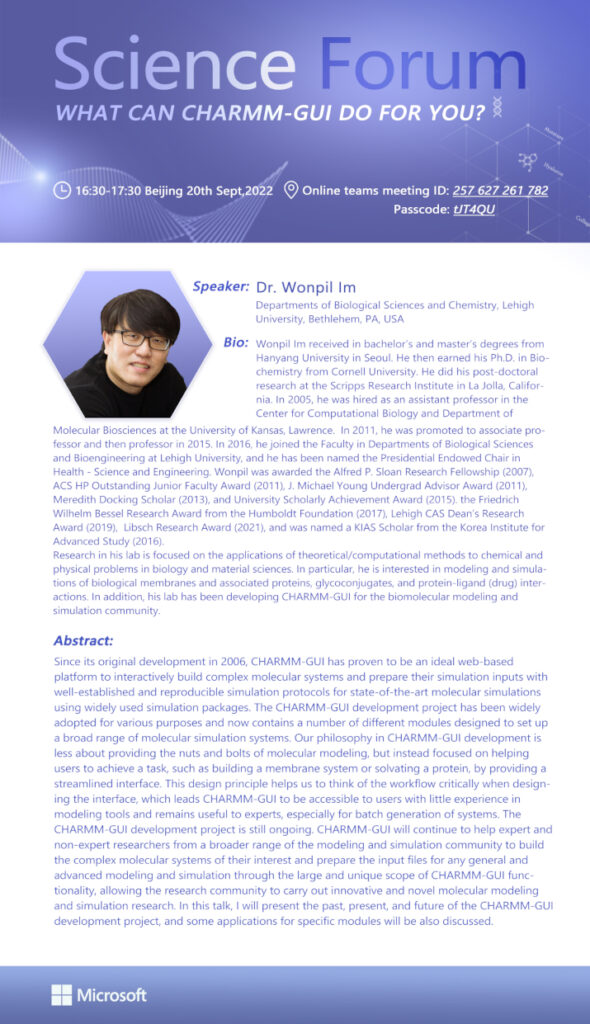
09/13/2022: Epigenomics in health and diseases: recent advances and computational challenges(健康和疾病研究中的表观基因组学:最新进展和计算挑战), Dr. Yanxiao Zhang
-
Abstract: As we all know, DNA is the basis for inheritance. Epiegenetics is the study of heritable phenotype changes that do NOT involve alterations in the DNA sequences. Epigenetics, by the broad definition, includes DNA methylation, histone modifications, noncoding RNA and so on. They act together to dictate the fate of cells, i.e., how stem cells differentiate into hundreds of different cell types in our body. When these processes are compromised, it could result in a variety of diseases, including developmental diseases, cancer, and aging, to name a few. In this talk, I will introduce some mainstream genomics technologies that could help us measure the epigenetic states of our cells, their data analysis strategies, and their application in research. I will also try to highlight several computational challenges in the field.
Bio: Dr. Yanxiao Zhang received his bachelor’s degree in Biotechnology from Beijing University in 2010. He then obtained a PhD degree in Bioinformatics (advisor: Dr. Maureen Sartor) and master’s degree in Statistics from the University of Michigan in 2016. He completed his postdoctoral work in Dr. Bing Ren’s lab at Ludwig Institute for Cancer Research (UCSD branch), studying the dynamics of chromatin states during mammalian development (as part of ENCODE) and 3-dimenstional chromatin structure. Dr. Zhang joined Westlake University as an Assistant Professor in January 2022. His lab will use computational and functional genomics tools to study the mechanisms of aging and cancer, with a primary focus on epigenetic regulations. For more info please visit: https://zhangyxlab.github.io/
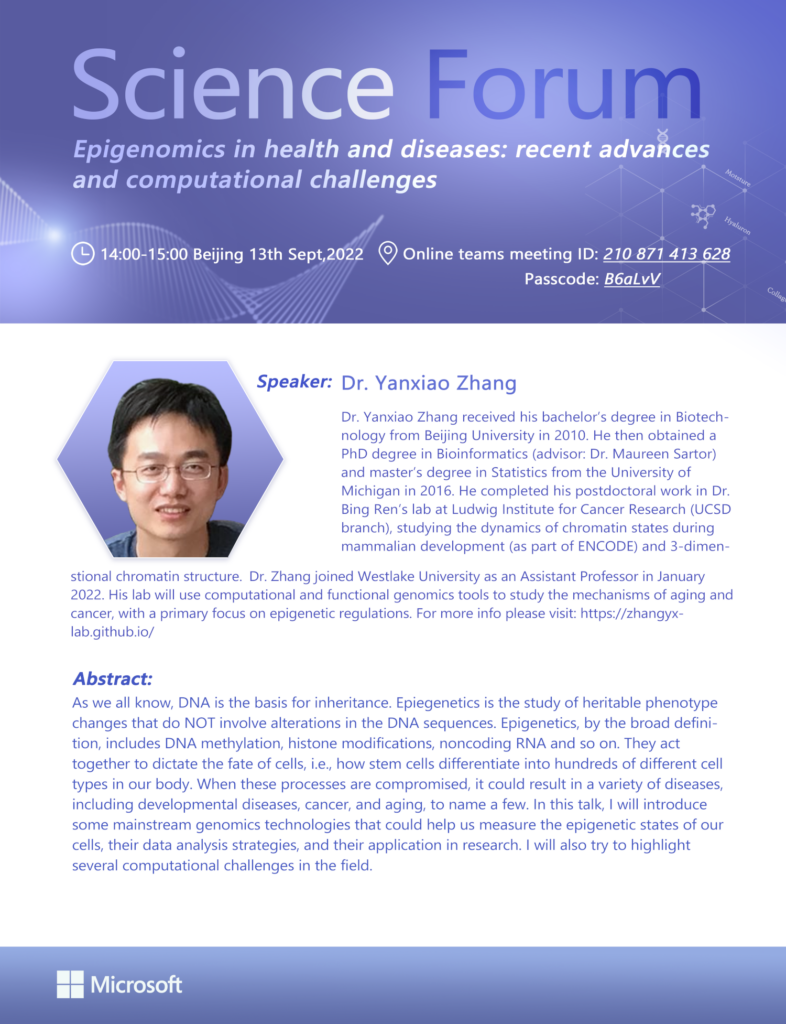
08/30/2022: Visual information decoding and restoration(视觉信号的解码与再现), Dr. Jiayi Zhang
-
Abstract: Jiayi Zhang has utilized inter-disciplinary approaches to develop novel technologies for decoding visual information and treating neural (visual in particular) disorders. The speaker will touch on the following studies: 1) Restoration of vision in blind mice using titanium oxide nanowires as artificial photoreceptors. 2) Development of a multisite optogenetic stimulation device, which has the potential to improve rehabilitation of paralyzed upper limb. 3) a visual camouflage system that changes colors of electroluminescent fibers in real-time response to the color change in the environment. 4) Near-infrared manipulation of multiple neuronal populations via trichromatic upconversion. 5) Coding of timing information in the visual cortex. Jiayi Zhang has published multiple papers in journals including Neuron, Advanced Materials and Nature Communications (corresponding author) in the past five years, which was cited for over 1000 times.
Bio: Dr. Jiayi Zhang received her B. Sc. Degree from Hong Kong Baptist University and Ph.D. degree from Brown University. She was a Brown-Coxe postdoctoral fellow in Yale University and joined Institutes of Brain Science at Fudan University in 2012. She is currently the vice director of State Key Laboratory of Medical Neurobiology. Her recent work focused on the decoding and restoration of vision. Her work was published in journals including Neuron, Advanced Materials and Nature Communications. She got the Young Innovative Woman Award in Shanghai in 2020. She serves as the Vice chairman of the Young Scholar Panel and fellow for Chinese Association for Physiological Sciences (CAPS) as well as the Vice chairman of the Sensory and Motor Panel, Chinese Neuroscience Society (CNS).

08/11/2022: Orbital-free Density Functional Theory: Successes, Challenges, and Opportunities(无轨道密度泛函理论:成功、挑战与机遇), Dr. W. Chuck Witt
-
Abstract: The computational materials scientist regularly faces tradeoffs between accuracy and computational expense. Density functional theory (DFT) has become an enormously popular tool because it retains much of the accuracy of quantum mechanics at modest cost. DFT calculations—on topics as wide-ranging as battery design and the nature of planetary cores—contribute to thousands of scientific papers and consume a significant fraction of worldwide supercomputing time each year. Orbital-free DFT, which bypasses all wave function operations, achieves further large efficiency gains over standard DFT; however, the orbital-free variant is presently less accurate for much of the periodic table. This talk will introduce orbital-free DFT in a manner accessible to an interdisciplinary audience, highlighting successes, challenges, and opportunities for improvement.
Bio: Dr. Chuck Witt is a Junior Research Fellow in the Materials Theory Group at the University of Cambridge, as well as a Schmidt Science Fellow. His interests include the development of methods and software rooted in quantum-mechanical first principles, as well as their application to problems in materials science and engineering. He earned a PhD in Mechanical and Aerospace Engineering from Princeton University.
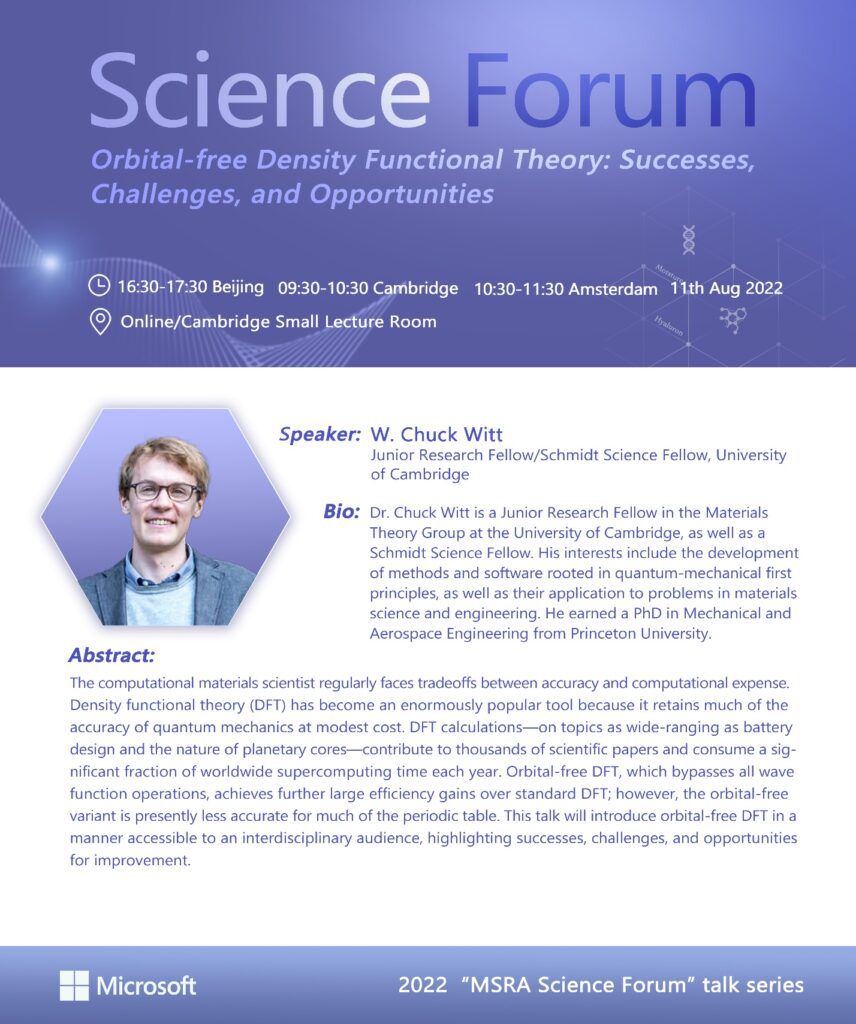
08/08/2022: Deep learning based insights into key bacterial pathways(关键细菌通路的深度学习探索), Prof. Jeffrey Skolnick
-
Abstract: Accurate descriptions of protein-protein interactions are essential for understanding biological systems. Remarkably accurate atomic structures have been recently computed for individual proteins by AlphaFold2 (AF2). We demonstrate that the same neural network models from AF2 developed for single protein sequences can be adapted to predict the structures of multimeric protein complexes without retraining. In contrast to common approaches, our method, AF2Complex, does not require paired multiple sequence alignments. It achieves higher accuracy than complex protein-protein docking strategies and provides a significant improvement over AF-Multimer, a new development of AlphaFold for multimeric proteins. Moreover, we introduce metrics for predicting direct protein-protein interactions between arbitrary protein pairs and validate AF2Complex on challenging benchmark sets and the E. coli proteome. Using the cytochrome c biogenesis system I as an example, we present high-confidence models of three sought-after assemblies formed by eight members of this system. Then, we introduce a high-throughput, deep learning pipeline to identify PPIs within the E. coli cell envelope and apply it to several proteins from an OMP biogenesis pathway. Thus, we have developed a general strategy for investigating biological pathways by using structural insights gained from deep learning-based predictions.
Bio: Jeffrey Skolnick is a Regents’ Professor and Director of the Center for the Study of Systems Biology in the School of Biological Sciences at the Georgia Institute of Technology. He is also the Mary and Maisie Gibson Chair in Computational Systems Biology and a Georgia Research Alliance Eminent Scholar in Computational Systems Biology. He received a Ph.D. in Chemistry from Yale University. Among his awards are the Southeastern Universities Research Association (SURA) Distinguished Scientist Award, the Sigma Xi Sustained Research Award, and an Alfred P. Sloan Research Fellowship. He is a Fellow of the AAAS, the Biophysical Society, and the St. Louis Academy of Science. He has authored over 400 publications, has an h-index of 92, and has served on 16 editorial boards. Dr. Skolnick’s current research interests are in computational biology and bioinformatics with a major emphasis on precision medicine and drug discovery. He has developed and applied AI approaches to predict disease mode of action proteins, the prediction of drug efficacy and side effects and studies on the interrelationship of all human diseases. He has applied these ideas to predict the origin and possible treatments of long COVID, aging, cancer, and chronic fatigue syndrome. He has also done substantial research on the possible origins of the biochemistry of life and molecular simulations of subcellular processes.
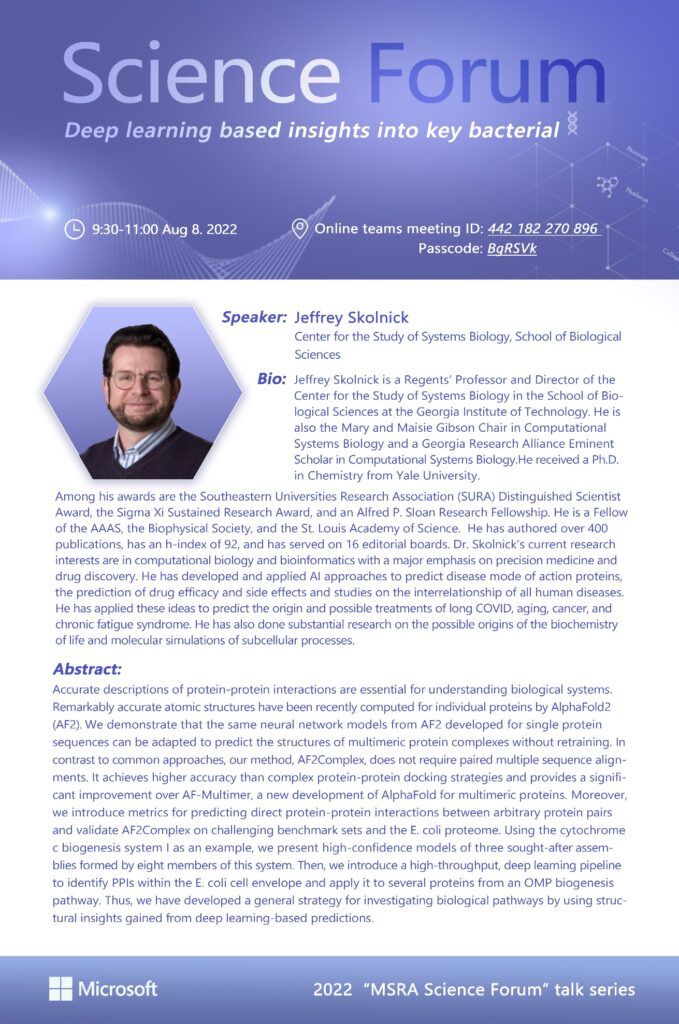
08/02/2022: Jet Tagging in the Era of Deep Learning(深度学习时代的粒子对撞研究), Dr. Huilin Qu
-
Abstract: Machine learning has revolutionized the analysis of large-scale data samples in particle physics and greatly increased the discovery potential for new fundamental laws of nature. Specifically, deep learning has transformed how jet tagging, a critical classification task at high-energy particle colliders such as the CERN Large Hadron Collider (LHC), is performed, leading to a drastic improvement in its performance in the past few years. In this talk, Dr. Qu will go through recent progress in deep learning approaches for jet tagging and their applications in Higgs boson studies and new physics searches at the LHC. Prospects and possible future directions will also be discussed.
Bio: Dr. Huilin Qu is a Senior Research Fellow at CERN. He received his B.S. degree from Peking University in 2014, and Ph.D. from University of California, Santa Barbara in 2019. His research has focused on searches for new physics and measurements of the Higgs boson properties with the CMS experiment at the CERN LHC, particularly using novel approaches and advanced techniques such as machine learning. He played a key role in searches for the Higgs boson decaying to a pair of charm quarks, for Higgs boson pair production in the high-momentum regime, and for supersymmetric partners of the top quark. In addition, Huilin is active in machine learning research for jet physics. He proposed a series of novel deep-learning approaches for jet tagging, which substantially improved the performance and have been widely adopted at the LHC and beyond.
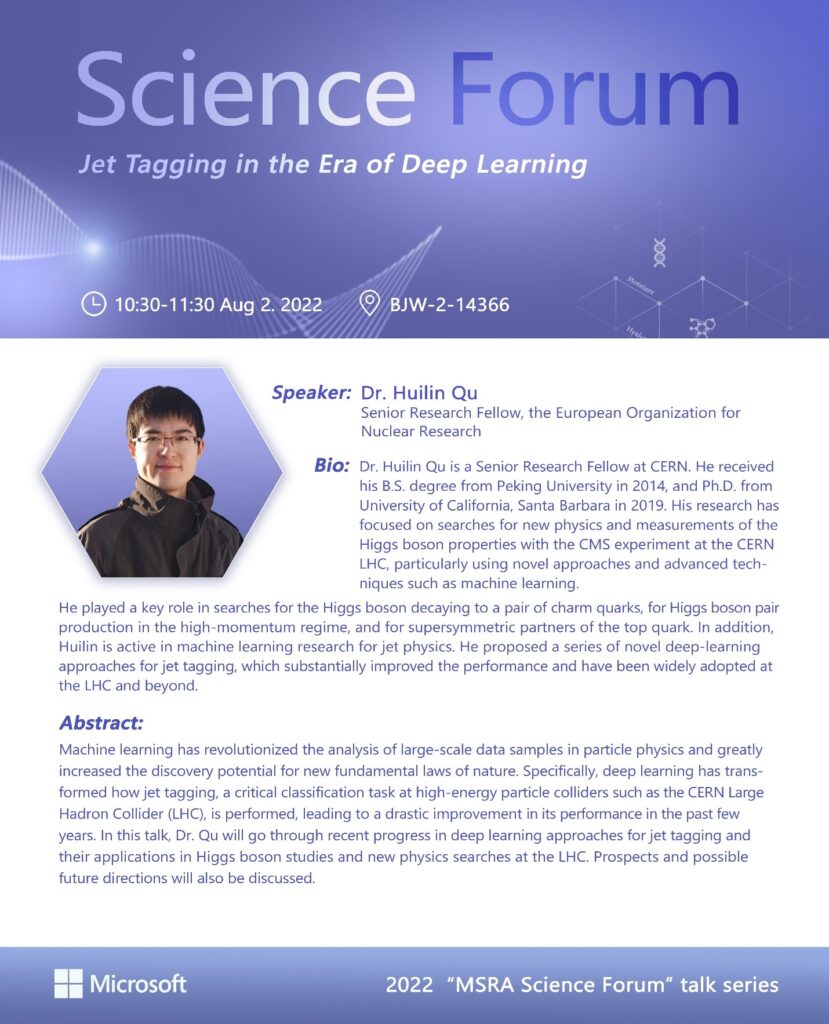
07/20/2022: Paving a data-centric high-way for materials science(数据驱动材料科学), Prof. Miao Liu
-
Abstract: In this talk, the speaker will be presenting how he takes all the technologies that have disrupted other industries and start to disrupt his own. Leveraging the recent advance in the high-throughput first-principles calculations, his team has recently released a world-class materials database, namely atomly.net, to bring the high-quality materials science data to the fingertips of scientists worldwide. Atomly.net contains the high quality first-principles calculation results of more than 300k inorganic materials and many related properties, including but not limited to the crystal structure, electronic structure, elasticity, dielectric tensor, etc.
Taking the advantage of the massive trove of data, it becomes feasible to screen, predict, and discover new materials in an expedited and cost-effective manner. For example, identify the possible Kagome materials [Chin. Phys. Lett. 39 047402 (2022)], screen the feasible superconductor [Phys. Rev. B 105, 214517 (2022)], and build generic artifactual intelligent models for property prediction [arxiv.org/abs/2108.00349].Bio: Miao Liu is an associate professor at the Institute of Physics, Chinese Academy of Sciences, and a joint scientist at the Songshan Lake Materials Laboratory. His research revolves around data-driven materials science for energy materials, alloys, quantum materials, etc. Dr. Liu was trained as a physics major at the beginning and got his Ph.D. from the University of Utah in Materials Science and Engineering afterward. He then joined the Materials Project team at Lawrence Berkeley National Laboratory as a postdoctoral researcher and developed the behind scene database management modules. He started his career at the Institute of Physics in the year 2018 and found the Atomly materials science database from scratch. Atomly now is one of the world’s foremost databases of its kind.
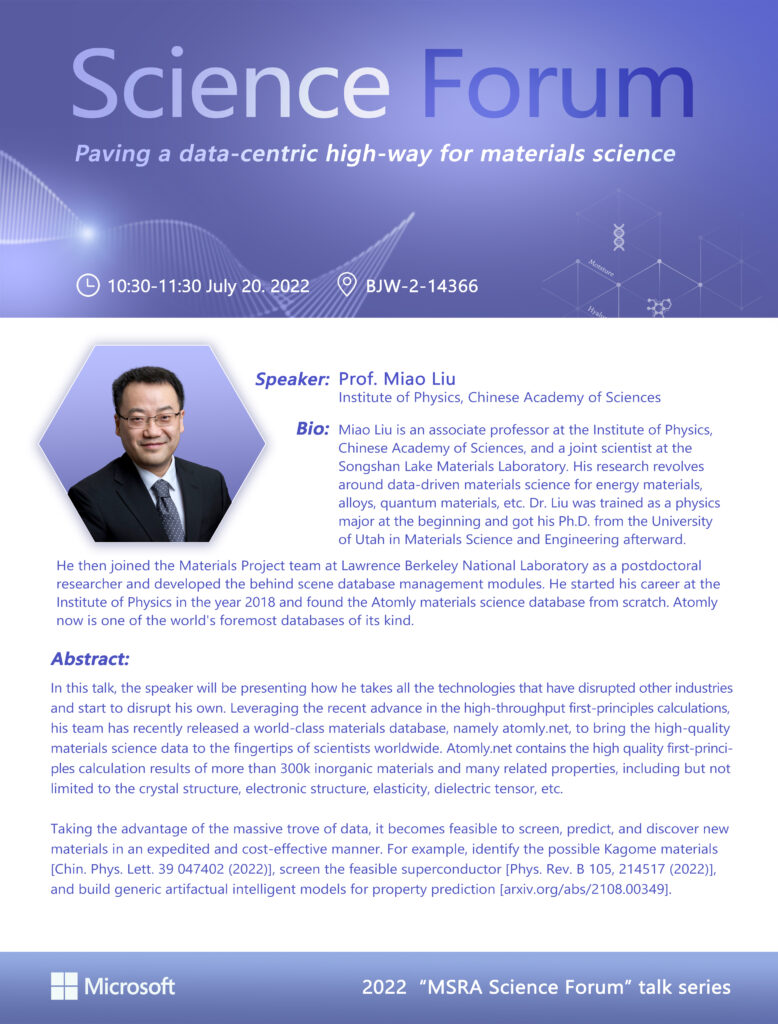
07/13/2022: 3-D Structure-based drug discovery — Rational design of small molecules, proteins and viruses for therapeutic industries(三维结构药物发现), Prof. Xiao-Dong Su
-
Abstract: There are several seminal advances in the biomedical fields in the recent 10 years that signal some major transition may take place in drug discovery research. The transition includes traditional small organic and protein molecule base drugs and therapies towards cellular and vector-based gene therapies. I will review mostly from 3-D structural viewpoints some of the traditional aspects of current drug discovery to future cellular and AAV (adeno associated viruses) vector-based gene delivery and therapies.
Bio:
2003.01 – present, Professor of Biochemistry and Molecular Biology (Cheung Kong Scholar), School of Life Sciences, Peking University, Beijing, P. R. China.
2001.11 – 2002.12, Associate Professor at Department of Molecular Biophysics, Center for Chemistry and Chemical Engineering, Lund University, Sweden.
1998.04 – 2002.04, Assistant professor at Dept. of Molecular Biophysics, Center for Chemistry and Chemical Engineering, Lund University, Sweden.
1995.07 –1998.04, Research associate with Howard Hughes Medical Institute (HHMI) at Division of Biology, California Institute of Technology, USA.
1988 .11- 1994.12, Ph.D. candidate at the Department of Cell and Molecular Biology, Karolinska Institute, Sweden
1985.09-1987.07, Graduate study at the Health Science Center, Peking University, China. 1980.09-1985.07, B.Sc. in solid state physics. Department of
Physics, Peking University, China.
His research interests include structural biology, biochemistry and molecular biology, single-molecule biophysics, next-generation genome sequencing technology, structure-based drug and antibody engineering and rationalization design. Since receiving his Ph.D. in 1994, he has published nearly 200 academic papers in international authoritative academic journals such as Cell; Nature; Science; Nature Cancer; Nature methods; Nat. Strucut. & Mole. Biol. (NSMB); National Science Review(NSR);Annu. Rev. Pharmacol. Toxicol.; Genome Research; PNAS; Cell Research; EMBOJ.; EMBO Rep.; Cell Reports.; Cell Discovery;Nucleic Acid Research (NAR) and other internationally renowned academic journals and translated 6 books and books (including chapters in the book), and translated the best-selling textbook of structural biology, Structural Biology – From Atoms to Life.
12/14/2021: High performance large scale atomistic material simulations: the challenges and opportunities(高性能、大尺度原子级材料模拟:挑战和机遇), Prof. Lin-Wang Wang
-
Abstract: The ab initio material simulation based on quantum mechanics has been developed for more than forty years. With the maturity of the methods, the developments of user-friendly codes, and the increase of high-performance computer power, the atomistic ab initio methods, especially the methods based on density functional theory, have been used in every aspect of material research. It is not a common practice to simulate systems with hundreds of atoms. However, since the computational cost scales as the third power of the number of atoms, new strategies are needed to go beyond this barrier. Furthermore, a huge gap exists between the computable systems and many of the experimental systems, both in size scale and temporal scale. How to bridge this gap is a main challenge in order to bring the ab initio computation into industry. To overcome such challenges, we need to use multiple methods, including linear scaling method, machine leaning method, and new scheme for high performance computation. I will discuss some of these efforts in LongXun KuanTeng Inc.
Bio: Lin-Wang Wang: Chief scientist in Semiconductor Institute, CAS, and chief scientific advisor in LongXun Kuang Teng Inc. Senior Staff Scientist, Lawrence Berkeley National Laboratory, Berkeley, CA, U.S. 1999-2021. Dr. Wang has 30 years of experience in large scale electronic structure calculations. He has worked in O(N) electronic structure calculations in early 1990s. Worked with Alex Zunger, he invented the folded spectrum method which pushed the limit of non-self-consistent electronic structure calculations from 100 atoms to thousands of atoms. He developed a linear combination of bulk bands (LCBB) method for semiconductor heterostructure electronic structure calculations, which allows the calculation of million atom devices. He developed generalized moments method which calculates the density of state and optical absorption spectra of a given system without explicit calculation of its eigenstates. He also developed a popular parallel total energy plane wave pseudopotential program (PEtot). He invented a charge patching method, which enables the ab initio accuracy thousand atom calculations for nano systems. He has developed a linear scaling three-dimensional fragment method (LS3DF), which can be used to selfconsistently calculate systems with tens of thousands of atoms. Recently, he developed a new algorithm for real-time time-dependent DFT calculations which accelerates the traditional algorithms by hundreds of times.

12/14/2021: Broadly neutralizing antibodies against SARS-CoV-2 variants(针对SARS-CoV-2变种的广谱中和抗体), Prof. Linqi Zhang
12/14/2021: Structural insights into the infection and evolution of the highly pathogenic human coronaviruses(高致病性人类冠状病毒感染和进化的结构研究), Prof. Xinquan Wang
12/14/2021: Enhancing the protein conformational sampling in molecular simulation(分子模拟中的蛋白质构象采样增强), Prof. Haipeng Gong

